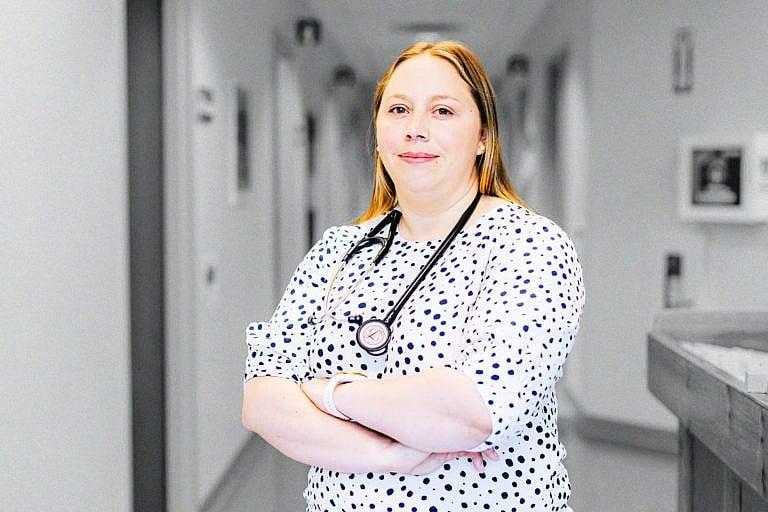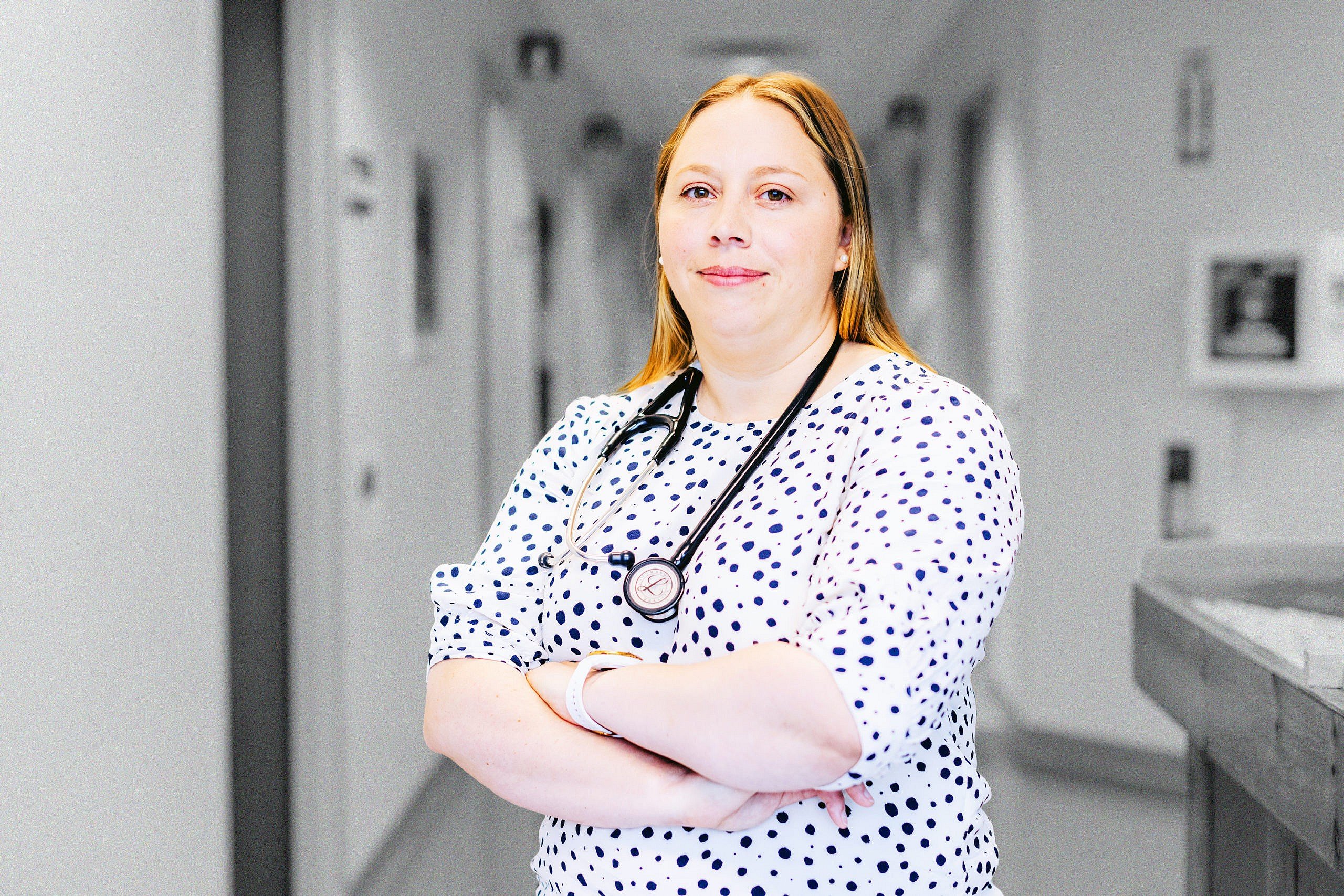I’m a family doctor in Halifax. Pay-for-service clinics will burden the public system.
A renewed interest in pay-for-service clinics could restrict health care access for those who need it most

“A renewed interest in pay-for-service clinics creates a huge risk,” says Dr. Leisha Hawker, who has worked in Nova Scotia’s public health-care sector for over a decade (Photography by Matt Madden, Illustration by Maclean’s)
Share

I’ve worked as a family doctor in Nova Scotia’s public health sector for a decade. These days, I’m at a collaborative health centre in Halifax that offers primary care, dental care, mental-health support and other services. I’ve been watching our provincial system inch closer and closer to collapse since I became a physician back in 2013. It’s a story that’s now common to most other provinces, but Nova Scotia has its own specific problems: 14 per cent of the people who live here have no family doctor and, worse, a quarter of our working physicians are older than 60. When they retire, our system will be even more strained.
READ: Thousands of patients. No help. Meet the lone family doctor of Verona, Ontario.
The sentiment that public health care is failing Canadians has led to the creation of many private health care clinics, which have popped up around the country within the last year, including one in Nova Scotia. I suspect that the idea behind them is to provide patients with more timely care. But, in my opinion, a renewed interest in pay-for-service clinics creates a huge risk—and could potentially restrict health care access for those who need it most.
Private clinics that are run by nurse practitioners and require Canadians to pay out of pocket for services, while not in contravention of the Canada Health Act, flirt with the spirit of that legislation, which states that patients can’t be charged for medically necessary care. These clinics are still allowed to exist because, when the Act was written in 1984, care from a nurse was not considered medically necessary (and therefore covered under provincial insurance plans), nor was treatment from professionals like psychologists, physiotherapists and dentists. This language should be revised, because the more that professionals in those “non-necessary” categories privatize, the more we risk creating an even greater rift, a two-tiered system that could leave the most vulnerable members of our population behind.
RELATED: An impossible job: What it’s like to work in a pediatric ICU
What’s happening in Canadian health care right now is not dissimilar to how the customs queues work at airports. There’s a priority line for experienced, affluent travellers who are willing to pay for a Nexus card. That line moves quickly, but it still requires personnel to manage it. This pulls workers from the regular line, which jacks up wait times for travellers who are unwilling or unable to pay a premium. There are also two lines in a two-tiered health care system: a private route for those who will pay and a free route for everyone else. Patients in the free line are, on average, less healthy, as low socioeconomic status is tied to worse health outcomes. The effort of treating more complex conditions slows down the queue. As more private-care facilities crop up, many medical professionals may prefer to work in those spaces, with patients who are healthier. Those clinics may also offer more flexible shifts, a real boon for providers burnt out after years of working overtime. But where does that leave the public patients?
At our clinic in Halifax, we work with patients on long-term disability, newly arrived refugees, people struggling with addictions and others who are insecurely housed. They are already at a disadvantage, because the wait for services like public physiotherapy and dental care is very long. In fact, I often find myself treating dental abscesses because of that lack of access. Those disadvantages will only compound if medical professionals abandon the public system for private options.

Studies have repeatedly shown that not only does a parallel private health care stream not reduce the burdens on the public one, it can actually increase them by reducing the number of doctors available, funding and overall public support. As an example, earlier this month, the federal government clawed back a total of $82 million in health care funding for provinces who were allowing private providers to charge patients for MRIs, CT scans and other tests. That included the $1.2 million that was taken from Nova Scotia.
The worry that the public system cannot care for everyone is definitely out there. I’ve spoken with physicians who say their patients, faced with long delays, feel pushed to resort to private options. This is exactly why it’s crucial to focus on and bolster retention within the public system. One way to do that is to fund more spots in local medical schools and find ways to train and license more professionals. In Nova Scotia, we’ve already begun doing the latter: as of early March, U.S.–certified doctors can practise here without having to first pass a licensing exam. The province also recently announced a $10,000 retention bonus for nurses in the public system, and extended offers to 65 Kenyan refugees, who will begin working as continuing-care assistants as of this summer. All of this is a good start, but our dearth of medical professionals is the result of decades of under-resourcing. It will take years to get out of this hole.
One of the most impactful solutions we should be funding is more of what we in Nova Scotia call “medical homes,” or health centres with a range of medical professionals under one roof. (These are known as family health teams in Ontario, and have other names in other provinces.) These models relieve the workload of overburdened nurses and doctors and ER workers whose job is to focus on treating time-sensitive, life-threatening illnesses, and they offer patients many more options than waiting to see their GP or going to the ER. At our clinic, they can consult with a family doctor, a social worker, a dental hygienist, a psychiatrist, an OB-GYN and more. Together, we collaborate on care strategies for patients whose health problems are multi-faceted. Some of our patients access four or more different services at our centre within a month. That wouldn’t be possible if each service was separate and privatized.
To be clear, I see the appeal of publicly funded, private health care establishments, like walk-in clinics, for example. Those are important services that alleviate the public system without charging patients. In fact, that’s how the relationship should remain: private as a complement to public, not costing patients money and not exacerbating human resource shortages. It’s worth remembering that health care is not a commodity; it’s a public good.
–As told to Alex Cyr